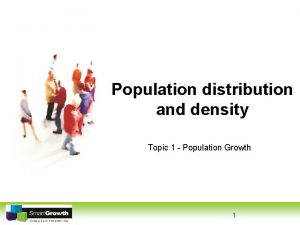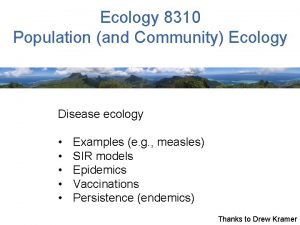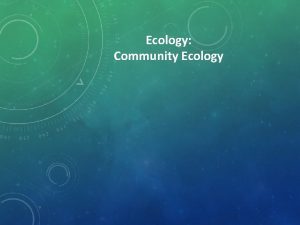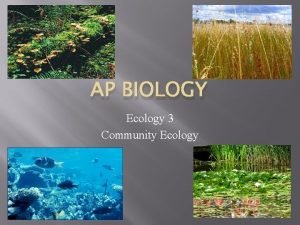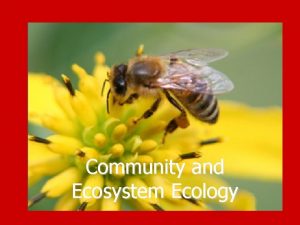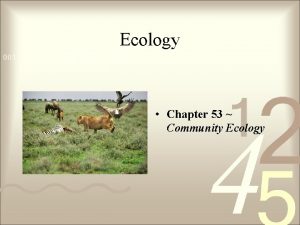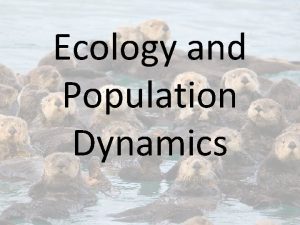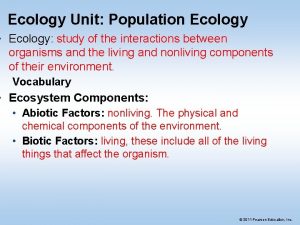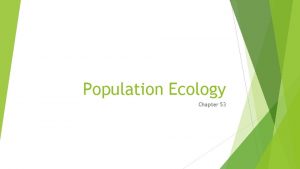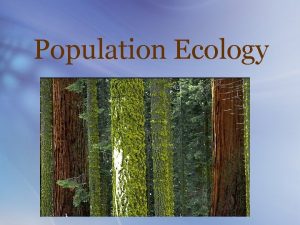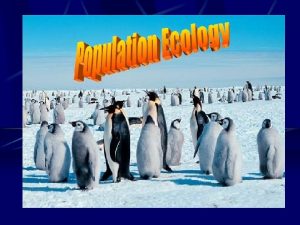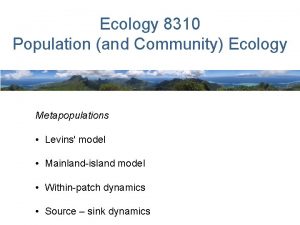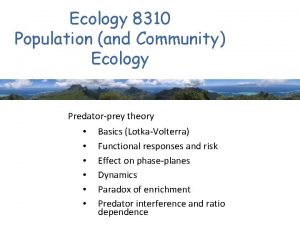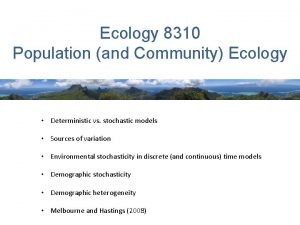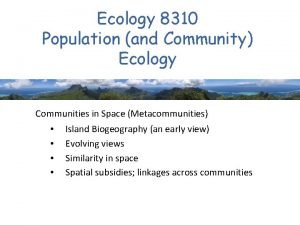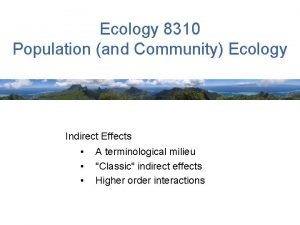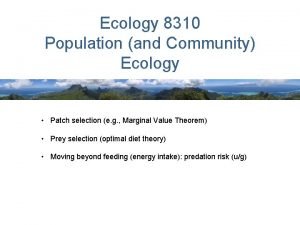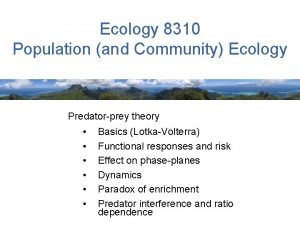Population and community ecology Population ecology 1 J






















- Slides: 22

Population and community ecology Population ecology 1 J Gerber and J Goliath

Terminology l l l l 2 Species Habitat Population Community Ecosystem Ecology Ecological niche J Gerber and J Goliath

Size of a population Definition and impact on population size: l Natality l Mortality l Dispersal (including immigration, emigration and migration) Aspects of population fluctuation and regulation: l Carrying capacity l Environmental resistance/limiting factors and its impact on population growth l The effect of annual and seasonal fluctuations on population size 3 J Gerber and J Goliath

Size of a population Characteristics of the following growth patterns/forms: l Geometric growth form (J-shaped curve) l Logistic growth form (S-shaped curve) Methods to determine population size, demographics and population movements: l Direct technique (census) l Indirect technique – simple sampling and mark recapture 4 J Gerber and J Goliath

Activity 1 - Terminology Instructions l Explanation of activity on terminology. l In pairs/groups define the terms on the work sheet given. l After 10 minutes each pair/group give feedback. 5 J Gerber and J Goliath

Terminology l Species – Group of organisms with similar characteristics which can interbreed to produce fertile offspring l Habitat – Specific type of environment (area) in which a plant or animal species normally occur Population – Group of organisms of the same species that occur in a particular area in a particular time so that interbreeding occurs l 6 J Gerber and J Goliath

Terminology l l l 7 Community – Group of populations occurring in a particular area e. g. lion, zebra and giraffe in a National Park. Ecosystem – Interaction between the biotic factors and abiotic factors in a particular area Ecology – Study of mutual interaction among living organisms and environment in which they live J Gerber and J Goliath

Terminology l 8 Ecological niche – Each species has a specific role in a community. Each species needs a particular set of environmental conditions and resources to survive and reproduce in its habitat J Gerber and J Goliath

Size of a population & population density Size of a population – the number of individuals in a population l Population density – the number of individuals of the population per unit of area l 9 J Gerber and J Goliath

Population parameters l l l 10 Natality – birth rate of a population expressed as the number of live births per thousand individuals per year. Mortality – death rate of a population expressed as the number of deaths per thousand individuals per year. Immigration – one-way movement of organisms into an area Emigration – one-way movement of organisms out of an area Migration – moves from one place to another and returns to the original place J Gerber and J Goliath

Impact of population parameters l l 11 Natality and immigration cause an increase in population size. Mortality and emigration cause a decrease in a population size. No immigration or emigration in a closed population e. g animals on an island. Natality and mortality can affect the population size in a closed population. J Gerber and J Goliath

Impact of population parameters 12 J Gerber and J Goliath

Population fluctuation and regulation l l 13 Carrying capacity – maximum number of individuals of a species that an ecosystem can continually supply resources to. Certain factors prevent a population from unlimited growth and exceeding its maximum growth rate – limiting factors and together are called environmental resistance. Seasonal fluctuations – Swallows fly from the cold European winter to Southern Africa where the summer temperature is more favourable. Annual fluctuation – Migration of millions of wildebeest in East Africa. This phenomen is determined by the availability of grazing which is also dependant on rainfall. J Gerber and J Goliath

Growth patterns/forms – Geometric or J – shaped curve l l 14 Population size increases unrestricted and rapidly with time. A population can reach its full reproductive potential because of enough food, water and no predators. Environmental resistance increases when numbers of population increase. Number of population can decrease rapidly due to limiting factors. J Gerber and J Goliath

Graph of repeated growth pattern 15 J Gerber and J Goliath

Logistic growth form (S - shaped) Lag phase: l Population acclimates, individuals become sexually mature and seek partners for mating. Accelerating growth phase l Population grows rapidly and reaches its maximum growth rate. Deceleration growth phase l Growth rate decreases due to an increase in environmental resistance. Equilibrium phase l Population numbers reach the carrying capacity. 16 J Gerber and J Goliath

Geometric and logistic growth phase 17 J Gerber and J Goliath

Methods to determine population size direct technique (census) l l 18 Count of all individuals in a population and includes human population census. Aerial photography may be used in the counting of larger animals in nature reserves. J Gerber and J Goliath

Indirect technique – simple sampling (quadrated method) l l l 19 A square frame (quadrat) is used Place it on the ground and count the individuals inside the quadrat It gives the number of individuals (density) per unit area Repeat in different places at random and calculate the average density Method is used for plants and slow moving animals J Gerber and J Goliath

Mark-recapture technique (Peterson) l l l 20 Demarcate a specific area. Capture a number of individuals, count and mark them (first sample). Set the marked individuals free in the area. Allow the marked individuals enough time to mix with unmarked individuals in the area. Capture a second number of individuals and count them (second sample). Count the number of previously marked individuals in the second sample. J Gerber and J Goliath

Mark-recapture technique l l l 21 Use this information to calculate the total size of the population by means of the following formula: P=mxs t P = estimated population size. m = total number of animals captured and marked in first sample. s = total number of animals captured in second sample. t = number of marked individuals in second sample. J Gerber and J Goliath

Mark-recapture technique - validity l l l 22 Marking methods should not injured the organism. Marks should be clear for the duration of the investigation. Marking methods should not affect the movement of the animals. Marked organisms should be allowed enough time to mix. Population must be closed. Period between two samplings should be sufficiently brief – no births or deaths. J Gerber and J Goliath
 Population ecology section 1 population dynamics answer key
Population ecology section 1 population dynamics answer key Population ecology section 1 population dynamics
Population ecology section 1 population dynamics Population ecology section 1 population dynamics
Population ecology section 1 population dynamics Chapter 4 population ecology section 1 population dynamics
Chapter 4 population ecology section 1 population dynamics Ecology
Ecology Ecosystem vs community
Ecosystem vs community Evolution and community ecology guided notes
Evolution and community ecology guided notes Chapter 5 evolution and community ecology
Chapter 5 evolution and community ecology Chapter 5 evolution and community ecology answer key
Chapter 5 evolution and community ecology answer key Logistic growth ecology definition
Logistic growth ecology definition Define exponential population growth
Define exponential population growth Concept 3 population ecology
Concept 3 population ecology Chapter 53 population ecology
Chapter 53 population ecology Chapter 36 population ecology
Chapter 36 population ecology Chapter 4 population ecology answer key
Chapter 4 population ecology answer key Population ecology def
Population ecology def Chapter 53 population ecology
Chapter 53 population ecology Characteristics of population ecology
Characteristics of population ecology Chapter 4 section 1 population dynamics answer key
Chapter 4 section 1 population dynamics answer key Population characteristics ecology
Population characteristics ecology What is population ecology
What is population ecology Population definition ecology
Population definition ecology Population ecology
Population ecology






















